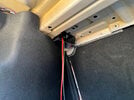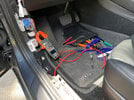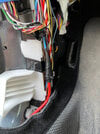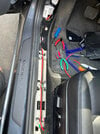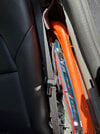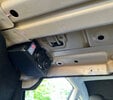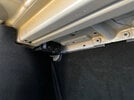I got a 12v fridge/cooler a few months ago for road tripping and was a little jealous of the Model Y folks who had their convenient 12v outlet right there in the trunk. Sure pulling the cable to the front wasn't the worst thing, but I always wished I had something slightly more convenient. I started with a panel from Blue Sea Systems and 3d printed an enclosure for it that could be bolted straight into some existing cutouts in the top of the trunk.
12v supply is tapped from the same wire that feeds the outlet in the center console from VCLEFT. This way I know there won't be anything funky going on with confusing VCLEFT about power draw that it's not expecting, and the outlet stays on so long as sentry mode is on. I didn't get any photos of the ground spot, but there's a 10mm bolt that's mirrored on both sides next to the rear seats with some sort of sensor (maybe an impact sensor for side airbags?). It was a little close to the HV charge port conduits on the driver's side, so I ran the wire in front of the penthouse over to the passenger side.
Overall not too bad, the worst part was trying to finagle the bolts into my enclosure, and dealing with pulling the wire along the existing wire looms. Now I can plug in my fridge without running the power cable between the seats up into the front console. It only draws around 5A at most when it's actively cooling on max, so I still have around 7A left up front that I can comfortably use if I had any other accessories that I wanted to use.
12v supply is tapped from the same wire that feeds the outlet in the center console from VCLEFT. This way I know there won't be anything funky going on with confusing VCLEFT about power draw that it's not expecting, and the outlet stays on so long as sentry mode is on. I didn't get any photos of the ground spot, but there's a 10mm bolt that's mirrored on both sides next to the rear seats with some sort of sensor (maybe an impact sensor for side airbags?). It was a little close to the HV charge port conduits on the driver's side, so I ran the wire in front of the penthouse over to the passenger side.
Overall not too bad, the worst part was trying to finagle the bolts into my enclosure, and dealing with pulling the wire along the existing wire looms. Now I can plug in my fridge without running the power cable between the seats up into the front console. It only draws around 5A at most when it's actively cooling on max, so I still have around 7A left up front that I can comfortably use if I had any other accessories that I wanted to use.



